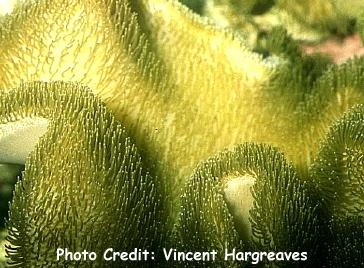
By Bob Goemans


Likely Reef Tank Suitable
Likely Fish-Only Tank Suitable
These photosynthetic corals are one of the more popular soft corals for the reef aquarium. There are many genera, e.g., Acrophytum, Alcyonium, Anthomastus, Bathyalcyon, Bellonella, Cladiella, Eleutherobia, Lobophytum, Malacacanthus, Metalcyonium, Minabea, Nidaliopsis, Parerythropodium, Sarcophyton, and Sinularia. Basically those from Alcyonium, Cladiella, Lobophytum, Sarcophyton, and Sinularia contain those of most interest to aquarists.
Identification of many of these species is very difficult because they are highly variable, i.e., shape can look quite different from another of the same species found elsewhere because of specific environmental factors. Environmental factors include temperature, salinity, light intensity, and water movement.
As with most leather corals, they do not respond well to being handled too often and seem to take longer periods of time to regain their full extension after each handling. It is very natural for them to coat themselves with a white/waxy film from time-to-time or especially when disturbed. Not to fear, as this protective coating will be shed when the animal is ready to expand its polyps. This layer of protective mucus also carries away coatings of algae and bacteria that may have troubled the animal. It is also thought this mucus coating is way to get rid of a layer of excess carbon that was produced via photosynthesis. However, frequent shedding could be a sign of poor water quality. Yet, size reduction at nighttime is thought to be a normal process in which the animal cleans itself of waste products/detritus.
Once established, and with sufficient light some may quickly go from tiny to gigantic. They should be started at lower light levels and slowly moved to an area where lighting is more intense. They may change their shade of color/protective pigments to some degree when they adjust their zooxanthellae level to match light intensity., and polyps are generally retracted at night.
Cuttings can easily propagate almost all species. Also, every week or so one should create a wave action by moving their hand through the water just above the animal or use a turkey baster to clean any detritus buildup from the polyp area, just like waves do in nature. Occasionally some are pestered by a nudibranch in the genus Dendronotus, which can bore into the corals and eat inside tissue. Remove when seen.
As for those in the genus Alcyonium, common names depend on the shape and color of the existing species and include: Finger Leather Coral, Dead Man's Finger Coral, Encrusting Leather Coral, Bushy Soft Coral, Yellow Bush Coral, Colt Coral, Red Finger Coral, and Chili Pepper Coral. Their growth takes a thick and encrusting form, many times with upward lobed finger-like outgrowth. They are found in calm turbid zones, do well in closed systems with moderate light and gentle water movement. In fact, this family of organisms is still in the stage of being identified, with possibly a morph from the Parerythropodium genus responsible for various color variations of A. fulvum more normally seen in the trade.
As for the Genus Cladiella, they are usually called Colt Coral, and these squat, tree-shaped photosynthetic soft corals have many branches extending, which are further divided. There are over 40 species and they are covered with various shades of brown polyps. Once established, they grow quickly and can get quite large. There is a white nudibranch, probably Tritonopsilla alba, sometimes associated with this species. They feed on the coral mostly at night and often leave powdery deposits at the coral's base. Sometimes these deposits are so excessive the coral separates from its base. Viewing your aquariums at night, possibly with the aid of 'moonlights' is a good way to view for nighttime predators. Remove these frilly looking nudibranchs with tweezers when seen.
Those in the Genus Lobophytum have common names such as Cabbage Leather Coral, Devils Hand Coral, Lobed Leather Coral, and sometimes Finger Leather Coral. These small to medium size photosynthetic soft corals do better under low to medium light with moderate water movement. They have several forms, including upward extending finger-like extensions covered in polyps, and irregular ear-shaped growth with a sparse covering of short polyps. They are usually light tan in color. Their body strengthening calcium carbonate sclerites can be seen through the skin tissue.
Probably some of the most popular are in the genus Sarcophyton. Their common names include Umbrella Coral, Elephant Ear Leather Coral, Toadstool Coral, Leather Coral, and sometimes Mushroom Leather Coral. These photosynthetic broad column shaped corals with large mushroom shaped tops are among the easiest soft corals to maintain. In the wild they are found on reef flats and lagoons in generally shallow waters and appear in various shades of brown. They do well under moderate to bright light with moderate water movement, and occasional water surges seem to be quite beneficial.
The last genus, Sinularia, contains well over 50 species and they have commons such as Scalloped Leather Corals, Finger Leather Coral, Cabbage Leather Coral, and Knobby Leather Coral. These photosynthetic soft corals, have irregular shaped growth with a sparse covering of short polyps or may have upward extending finger-like extensions covered in polyps. They are usually light tan in color and come in many shapes and sizes with most species seen in the trade preferring direct light. They also prefer moderate water movement.